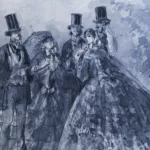
How to Write a Language Barrier
Communication is a cornerstone of any good characterisation. But for some characters there may be elements that block traditionally clear communication, and language barriers are just one example of that. Every interaction is filled with potential misunderstandings or revelations of clarity. Let’s explore how to bring language barriers to life in your writing, showing the struggles and triumphs that come with characters trying to connect across language and culture.
Understand the role of language in your story
- Consider the cultural and geographical context of your characters.
- Explore the historical ties or conflicts that might have led to the language differences.
- Determine the significance of the language barrier to the plot—is it an obstacle, a source of conflict, or a way to deepen character relationships?
- How can you use language to illustrate the power dynamics between characters?
- What is the emotional impact of miscommunication on all your characters?
- Why do you want to write about language barriers? If it’s just for the sake of a miscommunication trope, consider if there’s perhaps a better way for you to achieve the same aim.
- Have you taken the time to understand the culture whose language you are trying to represent?
Characterisation through language
- Incorporate a mix of languages or dialects to enrich the authenticity of the setting and the characters’ experiences.
- Pay attention to the non-verbal communication cues that can transcend language barriers, such as body language and facial expressions.
- Respectfully create characters with varying degrees of proficiency in the language they’re learning or interacting with.
- Use language as a way to show a character’s adaptability, intelligence, or stubbornness.
- Let characters’ reactions to the language barrier drive their development throughout the story.
- Consider how language barriers may influence a character’s inner thoughts and how they perceive the world around them.
The mechanics of writing dialogue
- Don’t overuse accents or continually spell them out. Use description to signal a character’s struggle instead of phonetically writing it.
- Suggest broken language skills by using simple words, or incorrect grammar, but don’t resort to stereotypes.
- If you choose to write an accent phonetically, don’t repeat this for every line of dialogue. Use it once as an example, and then use description to give the sense of it moving forward.
- Balance readability with authenticity—make sure the dialogue is understandable to your audience in a way that is still respectful to your character.
- Foster immersion through context rather than a direct translation of foreign words which often don’t hold the same meaning. Using vocabulary that characters and readers can deduce from context strengthens the narrative and characterisation.
- Present the characters’ linguistic progression realistically, showing their learning curve and how it affects their interactions.
Non-verbal communication
- Emphasise body language, facial expressions, and gestures to show communication without spoken language.
- Use context clues and the characters’ surroundings to help convey meaning.
- Explore how misunderstandings can arise from non-verbal miscommunications, but also show when non-verbal communication helps clarify things that can’t be conveyed verbally.
- Consider the situational context that might enhance or impede non-verbal understanding among characters. For example, in high-tension scenes, even subtle gestures can carry heavy meaning.
- Acknowledge cultural variations in body language and educate readers subtly through the narrative.
- Describe the physical environment as it can also influence the way characters use non-verbal communication—proximity, personal space, and even the weather can all play roles.
The emotional impact of language barriers
- Show how characters find innovative ways to express themselves and connect with others.
- Describe the frustration, isolation, or desperation that characters may feel when they can’t communicate.
- Use the language barrier to create poignant moments of miscommunication and resolution.
- Show how shared experiences can forge bonds that transcend words and even serve as a foundation for trust.
- Explore the characters’ emotional journeys as they navigate through their inability to communicate. This can lead to a deeper understanding of each other over time, despite the initial hurdles.
- Consider the long-term effects of language barriers on relationships and character psyche, both positive and negative.
Research and authenticity
- Study the languages you are writing about, including their structure and common phrases. If you’re writing a fantasy language, then research common language structures on which to base your characters’ experiences.
- Understand the culture tied to the language to avoid stereotyping and to provide richer detail. For real languages, do research, for fictional languages, work on some deep worldbuilding for authenticity.
- If possible, talk to speakers of the language you’re writing about, or speak to folks who have experienced a similar language barrier more generally.
- Seek feedback from native speakers or cultural experts to ensure accurate representation and to honour the community’s linguistic nuances.
- Be mindful of the socio-political influences on language and communication, presenting these complexities through your characters’ interactions either through worldbuilding, or researching real-world etymology.




























